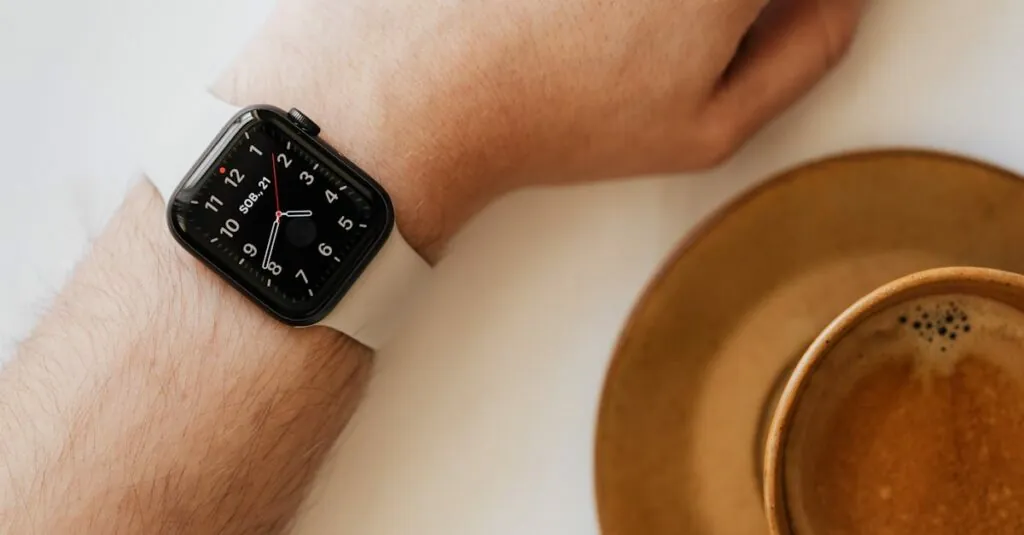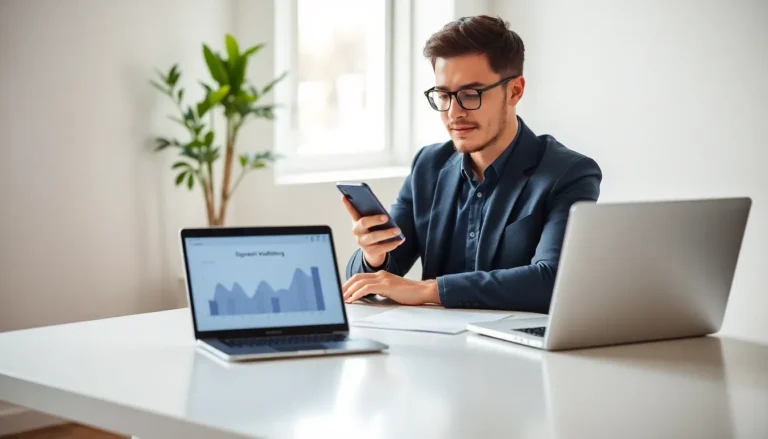Table of Contents
ToggleIn a world where scrolling through social media feels like a competitive sport, it’s easy to lose track of just how much time is spent glued to that shiny iPhone screen. Ever wondered if your phone’s become more of a best friend than a tool? Checking screen time on an iPhone isn’t just a good idea; it’s a wake-up call wrapped in a digital bow.
Overview of Screen Time on iPhone
Screen Time on iPhone offers users insights into device usage, helping them monitor their daily habits. This feature tracks time spent on apps, websites, and overall device engagement. Users can view detailed statistics, presenting a clearer picture of their digital consumption.
Insights from Screen Time empower individuals to set limits on app usage, encouraging healthier routines. Users can establish specific downtime periods, allowing breaks from notifications and distractions. Customizable app limits enable people to allocate time effectively, promoting mindful use.
Users can also enable notifications for Screen Time, ensuring they receive alerts when approaching set limits. This proactive approach helps maintain a balanced relationship with technology. With the option to view usage history, users can identify patterns, facilitating more informed decisions about digital habits.
Additionally, families can benefit from Screen Time by sharing settings across family members. Parents can monitor children’s usage, setting age-appropriate restrictions as necessary. This feature fosters open communication regarding device use and helps instill a sense of responsibility.
Overall, Screen Time serves as a vital tool for individuals aiming to enhance their connection with technology. By providing actionable data and promoting balanced usage, it encourages users to reflect on their behaviors and make necessary adjustments.
How to Check Screen Time on iPhone
Checking screen time on an iPhone involves simple steps that provide insight into personal device usage. Utilizing the Screen Time feature allows for effective monitoring of habits.
Accessing Screen Time Settings
To access Screen Time settings, open the Settings app on the iPhone. Scroll down and select “Screen Time.” After that, users can view their daily and weekly usage statistics. Tapping “See All Activity” reveals detailed insights into app usage. Adjust settings like Downtime and App Limits by selecting the respective options within the Screen Time menu. Accessing these settings provides a comprehensive view of digital habits and helps in managing device engagement more efficiently.
Understanding the Screen Time Interface
Understanding the Screen Time interface is crucial for effectively monitoring usage. The main interface presents a summary of screen time, app usage, and notifications received. Different categories show which apps consume the most time, allowing users to identify trends in their usage. A color-coded chart visualizes time spent on various categories, making it easy to understand app engagement. This interface makes it straightforward to set limits and customize downtime according to individual needs. Accessing these visual insights helps users make informed decisions about their digital habits.
Features of Screen Time
Screen Time on iPhone provides various features that enhance user experience and promote healthier device habits. The following sections delve into some specific aspects.
App Usage Stats
Tracking app usage statistics offers clear insights into how much time is spent on each application. Users can view daily and weekly breakdowns, making it easy to identify frequently used apps. Engaging with detailed usage data encourages users to evaluate their habits. Charts display time allocated to social media, gaming, and productivity tools, which are color-coded for quick comprehension. Additionally, insights allow the identification of excessive screen time, leading to informed choices about adjustments or reductions. Keeping an eye on these statistics fosters a more mindful relationship with technology.
Downtime and App Limits
Implementing downtime and app limits helps users establish boundaries for their device engagement. Downtime features allow users to schedule periods for device-free activities, reducing distractions. Users can select which apps remain accessible during these times, ensuring essential functions are still usable. App limits enable the setting of daily time restrictions for specific apps, enhancing self-regulation. Notifications alert users when they approach their defined limits, promoting proactive adjustments. These features work together, guiding users towards balanced habits while facilitating healthier interactions with their devices.
Benefits of Monitoring Screen Time
Monitoring screen time offers several significant benefits for users. Enhanced self-awareness results from understanding device habits and usage patterns. Many individuals gain clarity about how much time they spend on specific apps and activities, which helps identify areas for improvement.
Establishing healthy boundaries becomes easier with insights from screen time statistics. Setting time limits on certain apps fosters a sense of control and reduces excessive usage. Users can designate downtime for themselves, ensuring they engage in offline activities like reading or exercising.
Productivity often increases with mindful device engagement. By recognizing triggers for distraction, individuals can take proactive measures to limit interruptions. Focusing on specific tasks becomes more achievable when screen time is monitored.
Families benefit as well, particularly parents monitoring children’s device usage. Encouraging healthy digital habits early allows children to develop a well-balanced relationship with technology. Age-appropriate restrictions can prevent excessive screen time, supporting their overall well-being.
Tracking screen time contributes to improved mental health, too. Individuals can reflect on their digital consumption and its effects on mood and stress levels. Staying connected with real-life interactions fosters stronger relationships and enhances emotional well-being.
Making informed decisions is simpler with data from the Screen Time feature. Users can adjust their habits based on usage reports, which detail app engagement and time spent on social media. Awareness leads to positive changes that impact daily routines and lifestyle choices.
Integrating these monitoring practices cultivates a healthier balance between online and offline life. Users gain the ability to prioritize what matters most by reassessing their digital interactions. Prioritizing well-being through screen time awareness aligns technology use with personal goals.
Tips for Managing Screen Time Effectively
Establish daily goals for screen time to create boundaries. Setting an allowance for app usage encourages responsible habits. Utilize the Screen Time feature’s app limits to restrict specific applications, fostering discipline.
Incorporate scheduled downtime into daily routines. Enjoy device-free periods during meals or family time. Designating these intervals promotes healthier interactions and strengthens relationships.
Engage in offline activities to replace excessive screen time. Exploring hobbies, reading, or exercising diversifies experiences, reducing reliance on devices. Prioritize real-world connections to boost mental well-being.
Regularly review and analyze usage statistics to identify patterns. Observing trends in app engagement offers insight into time management. Adjust daily goals based on these findings to enhance balance.
Encourage family participation in screen time discussions. Setting shared goals builds a collective commitment to healthier habits. Shared monitoring fosters accountability, benefiting both parents and children.
Use reminders for daily efficiency. Notifications to limit usage help keep individuals focused on priorities. Timely alerts prompt users to take productive breaks and refocus their energy.
Participate in digital detox challenges periodically. Taking breaks from screens allows users to reset their relationship with technology. Committing to these challenges helps reinforce boundaries and improve overall habits.
Cultivate mindfulness in device usage. Being aware of emotional reactions while using apps can illuminate unhealthy patterns. Understanding triggers allows users to make informed decisions about device engagement.
Incorporate technology intentionally into daily life. Choosing when and how to use devices fosters a balanced lifestyle. It enables users to align screen time with personal priorities and well-being.
Monitoring screen time on an iPhone is more than just tracking usage; it’s about fostering a healthier relationship with technology. By utilizing the Screen Time feature, users can gain valuable insights into their habits and make informed decisions to enhance their daily routines. Setting limits and incorporating downtime not only promotes productivity but also encourages meaningful offline interactions.
Families can benefit immensely from shared settings, allowing parents to guide their children’s digital experiences effectively. As individuals reflect on their screen time, they can cultivate mindfulness and prioritize well-being. Embracing these practices leads to a balanced lifestyle where technology serves as a tool for connection rather than distraction.








